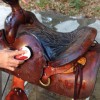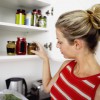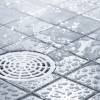 The South’s climate is appealing for equestrian activities. While riders enjoy the weather, it creates some challenges in caring for saddles and other tack. When the weather becomes hot and the humidity climbs and the rains are frequent, a tack room can become a breeding ground for mold and mildew. There are several things a rider can do, however, to lower the incidence of mildew on saddles and tack. This 3-page fact sheet was written by Joel McQuagge, Todd Thrift, and Ed Johnson, and published by the UF Department of Animal Sciences, November 2014. (Photo credit: Joel McQuagge, UF/IFAS)
The South’s climate is appealing for equestrian activities. While riders enjoy the weather, it creates some challenges in caring for saddles and other tack. When the weather becomes hot and the humidity climbs and the rains are frequent, a tack room can become a breeding ground for mold and mildew. There are several things a rider can do, however, to lower the incidence of mildew on saddles and tack. This 3-page fact sheet was written by Joel McQuagge, Todd Thrift, and Ed Johnson, and published by the UF Department of Animal Sciences, November 2014. (Photo credit: Joel McQuagge, UF/IFAS)
http://edis.ifas.ufl.edu/an303
Tag: Moisture Mold and Mildew
Closing Your Seasonal Home
 Get organized and make a plan before you lock your doors to leave your home for an extended period of time. Proper preparation inside and out will help ensure your return to a clean, undamaged home. Florida’s environment creates the possibility for mildew growth, storm damage, and pests. Unoccupied homes are more susceptible to these types of damage. This 6-page fact sheet provides the necessary steps to prepare your home before leaving for an extended period of time. There is also a checklist to help you remember. Written by Julie England, Audrey Norman, Randall A. Cantrell, and Maria J. Portelos-Rometo, and published by the UF Department of Family Youth and Community Sciences, June 2014.
Get organized and make a plan before you lock your doors to leave your home for an extended period of time. Proper preparation inside and out will help ensure your return to a clean, undamaged home. Florida’s environment creates the possibility for mildew growth, storm damage, and pests. Unoccupied homes are more susceptible to these types of damage. This 6-page fact sheet provides the necessary steps to prepare your home before leaving for an extended period of time. There is also a checklist to help you remember. Written by Julie England, Audrey Norman, Randall A. Cantrell, and Maria J. Portelos-Rometo, and published by the UF Department of Family Youth and Community Sciences, June 2014.
http://edis.ifas.ufl.edu/he887
Keeping it Clean: Controlling Mildew
 Mildew is a mold that can grow and cause damage to your health and home. The concern about mildew is that it is believed to contribute to respiratory problems, like asthma, especially in children. This 1-page fact sheet provides tips for preventing mildew and for getting rid of it. Written by Mary N. Harrison, Randall A. Cantrell, and Amanda Griffin, and published by the UF Department of Family Youth and Community Sciences, May 2014.
Mildew is a mold that can grow and cause damage to your health and home. The concern about mildew is that it is believed to contribute to respiratory problems, like asthma, especially in children. This 1-page fact sheet provides tips for preventing mildew and for getting rid of it. Written by Mary N. Harrison, Randall A. Cantrell, and Amanda Griffin, and published by the UF Department of Family Youth and Community Sciences, May 2014.
http://edis.ifas.ufl.edu/fy796
Investigating the Fungus Among Us: A 4-H Educational Curriculum on Mold (4HHLL70/4H311)
This unit investigates both the benefits and the dangers of mold or mold-based products. By completing the activities in each of the five lessons, youth (grades 5-8) will examine the positive and negative attributes of mold, the conditions that promote mold growth, and how growth can cause illness. They will also learn methods used to deal with mold growth in the home. This 58-page curriculum was written by Jessica Kochert and Joy Jordan, and published by the UF Department of 4-H Youth Development, March 2011.
http://edis.ifas.ufl.edu/4h311
FCS3301/FY1080 How to Clean Up Mold
FCS-3301, a 3-page illustrated fact sheet by Hyun-Jeong Lee, provides homeowners with basic guidance on assessing a mold problem, preparing for cleanup, and removal procedures, with links to other EDIS fact sheets for more detailed information. Includes references. Published by the UF Department of Family Youth and Community Sciences, January 2009.
http://edis.ifas.ufl.edu/FY1080